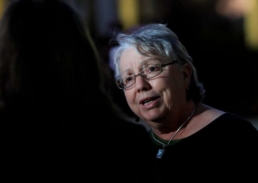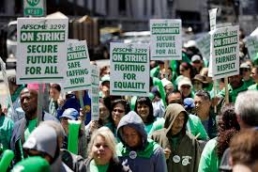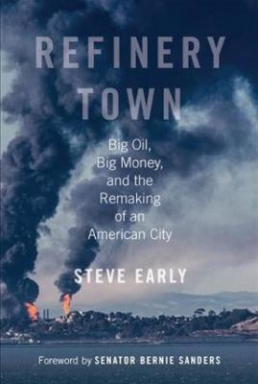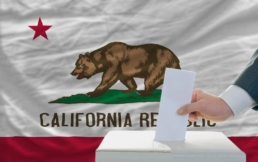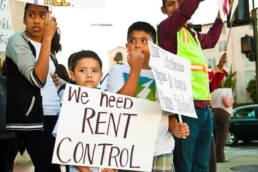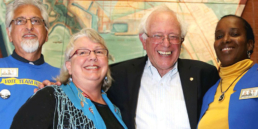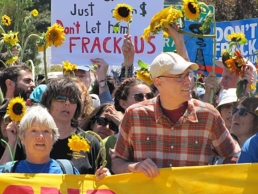‘Lite Guv’ No More: California Candidates Spending Millions For A Job That Gets No Respect
By Joe Garofoli /
The lieutenant governor’s position is so disrespected in California that its current occupant famously said California should “get rid of the position” if it wasn’t made more effective.
That isn’t happening. In fact, just the opposite is unfolding. The job mocked as “Lite Gov” in Sacramento has become downright politically sexy.
Two former ambassadors are running for the seat, as are a veteran state senator, a former Richmond mayor, a San Jose State University professor and a wealthy Los Angeles businessman — who has spent $2 million of his own money on the race and won the state Republican Party endorsement, even though he hasn’t attended a single candidates forum.
The lure of being one really long step from leading the world’s fifth-largest economy has inspired the June 5 primary candidates to collectively raise more than $10 million, and counting — far more than the $7.6 million that candidates raised for the entire election cycle the last time the seat was open in 2010, according to the nonpartisan National Institute on Money in State Politics.
That was the year Lt. Gov. Gavin Newsom was elected to the first of his two terms. Two years later, he told The Chronicle that his job as currently structured should be “dissolved” and that the governor and lieutenant governor should run the state as a team. Newsom, who now wants to be governor, has been quiet about that idea lately.
His would-be successors are spending all that money on an office that has an annual budget of $1.5 million, a staff of seven and little cachet. Other than checking in daily on the governor’s health, the lieutenant governor serves on the University of California Board of Regents, the California State University Board of Trustees, the State Lands Commission and the state Commission for Economic Development. He or she can also break ties in the state Senate as its president.
The top two finishers in the primary will advance to the November general election.
Millions of dollars are flowing into the race from outside groups, the largest of which is led by the California Medical Association. It is primarily funded by more than $4 million from Angelo Tsakopoulos, a Sacramento housing developer who is the father of Democratic candidate and former U.S. ambassador to Hungary Eleni Kounalakis.
With all these checks being cut, it isn’t surprising that money — specifically, who is funding whom — has become a focus of the race, particularly since the top three Democrats and one independent candidate agree broadly on most policy questions.
“Most dads might think about buying their daughter a pony. In this case, a dad wants to buy his daughter an executive seat,” said Gayle McLaughlin, the former Green Party mayor of Richmond who is running as a nonpartisan candidate and is not accepting corporate contributions.
McLaughlin is focusing on removing the influence of corporations in politics, saying, “As long as corporations have control of elected officials, nothing will change.”
She advocates tuition-free public universities and would pay for it by instituting a tax on millionaire residents and creating an oil severance tax on petroleum extracted in California.
Kounalakis shot back that “it really bothers me that Gayle would make this analogy,” referring to the pony line. “I’m a 52-year-old woman. Another woman should not try to paint their competitors as little girls. It’s not right.”
The San Francisco resident pointed out that her father immigrated to the U.S. as a young man from Greece to work as a farmworker. He built a development empire and became a politically influential donor in California long before his daughter ran for office.
“He’s so proud of me,” said Kounalakis, who also has donated $2.5 million of her own money to her campaign. “He wants me to win so I can help other families to walk the pathway of the American dream the same way.”
Kounalakis promised never to vote to raise tuition for University of California or California State University students. She also said she would turn the State Lands Commission into a weapon for opponents of President Trump, particularly when it comes to the administration’s proposals to loosen restrictions on coastal oil drilling. “This isn’t a sleepy little commission anymore with Donald Trump in the White House,” Kounalakis said.
Democratic candidate Jeff Bleich, a Piedmont attorney whom President Barack Obama appointed to be ambassador to Australia, said Kounalakis’ campaign is making it hard for Democrats “to have the moral authority to fight the influence of this kind of money in politics. We have to elect candidates who aren’t funded this way.”
Bleich proposes giving state university students a “debt-free” education in exchange for performing public service in California after they graduate.
Other candidates pointed out that Bleich has received more than $300,000 of his $2 million in campaign cash from other attorneys. Rival candidate state Sen. Ed Hernandez, D-West Covina (Los Angeles County), said, “What does that mean he will do for attorneys should he get elected?”
Bleich countered that Hernandez has been one of the Legislature’s largest recipients of money from pharmaceutical companies since 2011. “At the very least,” Bleich said, “people would wonder about the motivations for his positions.”
“I don’t have the luxury of self-funding my own campaign,” responded Hernandez, a practicing optometrist who has raised $2.8 million. He noted that he was a co-author of a law last year that requires drug companies to disclose how they price their products.
If elected, Hernandez said, “I would engage in health care like no lieutenant governor ever has” — focusing particularly on the 3 million Californians who lack coverage.
One of the few Republican in the race is Cole Harris,who parachuted in just before the March filing deadline. The Los Angeles import-export businessman hasn’t shown up at a candidates forum or filed a statement for the state voters guide, but he is spending about $250,000 a week on TV ads, saying, “I’ve got to build name ID here.
“You tell me how I’m supposed to do this. I didn’t have the luxury of announcing two years ago,” Harris said. He added that he could “put in another $10 (million) if I wanted to.”
Harris said he would focus on economic development and tap into the private sector for advice. “Not to drag on anybody here, but the best and the brightest don’t usually go into government,” he said.
Lydia Ortega, a Republican and professor of economics at San Jose State University, touts that she is not a politician. She wants to lower taxes and improve the state’s university system.
Ortega is the only candidate whom no one is targeting for her spending. That’s because she had $25,059 cash on hand as of April 21 — about as much as the California Medical Association-led outside group spent this month on billboards supporting Kounalakis.
This article was published 5/15/2018 on San Francisco Chronicle.
‘It’s Getting Unbearable’: UC Workers Protest Increasing Cost of Living, Call for Rent Freeze
By Sam Levin /
Demonstrators converged on Upper Sproul Plaza and marched to the Residential and Student Service Programs, or RSSP, office Thursday to protest rent increases and demand that UC officials freeze housing fees.
Protesters laughed, chanted and hoisted signs as the group grew from a handful of protesters at noon to about 100 by 12:30 p.m. The crowd included graduate students, undergraduates and the children of student-parents, who waved signs as their parents chanted or engaged with passers-by.
The rally also featured speeches by student representatives and Gayle McLaughlin, a candidate for California lieutenant governor and former mayor of Richmond.
This event comes in the wake of a newly announced rent hike, which will raise next year’s housing rates by an average of 4 percent, according to an email from David Surratt, associate vice chancellor of RSSP.
Another demand was revoking a new University Village policy that requires a $2 per hour guest parking fee at the village, which is in Albany. While campus spokesperson Adam Ratliff noted that University Village gives exemptions in certain situations, for others the fee can still add over $300 to their monthly rent, according to campus doctoral candidate Erin Greer.
“It’s hitting me really hard and I know there are people struggling more than me. … It’s getting unbearable,” said Rebekah Shtayfman, a campus junior and single mother living in University Village.
Protesters also objected to a clause in campus lease agreements that allows the university to evict tenants that it deems “emotionally unfit,” and called for all UC campuses to remove similar language from lease agreements. Ratliff confirmed in an email that this clause has been taken out of campus lease agreements.
By 12:45 p.m., the crowd began moving toward the RSSP office to deliver a letter outlining its demands to Surratt, chanting slogans such as “The rent is too damn high” as they filed up Bancroft Way and over to the RSSP building.
The letter to Surratt also called on the university to bargain with the UC Student-Workers Union, or UAW Local 2865, to establish affordable housing across the UC system. UAW Local 2865, which helped organize the rally, is a union representing academic student employees in the UC system and is currently negotiating a new contract with the UC Office of the President.
RSSP received a petition outlining demands from UAW Local 2865 in mid-April and again last week during a meeting with another host of the protest, the Village Residents Association, according to Ratliff. At last week’s meeting, Surratt told the union that he was not the appropriate campus representative to negotiate with, and referred them to campus human resources and labor relations.
Ratliff said the 4 percent rent increase at University Village was the result of increased costs that are beyond the RSSP’s control, and that RSSP worked to avoid price increases when possible and maintain rent at levels below local market value.
Two police officers lingered in the adjacent elevator lobby as protesters filed up the stairwell to Surratt’s fourth-floor office, where they chanted, read their demands through a bullhorn, delivered their letter and then sat down.
By 2 p.m. the crowd began to dissipate.
“We walked out strong today, but until our demands have been met, we will keep coming back stronger,” said Tashie Williams-Powell, a protester and former secretary of the Village Residents Association, in an email.
This article was originally published 5/3/2018 on The Daily Californian.
Gayle McLaughlin For Lt. Governor: The Only Progressive Choice
By Steve Ducey /
There are 11 candidates for California Lt. Governor on the ballot for the June 5th primary. Gayle McLaughlin is not only the clear choice for progressive voters, she’s the only candidate with the track record of success that makes her worthy of the office.
Lt. Governor is not the most glamorous title, and thus the race has not gotten much attention. Most voters are focused on the high profile governor’s race. But that’s exactly why this race matters. Front runner Gavin Newsom happens to be our sitting Lt. Governor, a position that has more importance than you might think.
Per Wikipedia:
"The Lieutenant Governor sits on the Board of Regents of the University of California, California State University Board of Trustees, Ocean Protection Council, California Emergency Council, and State Lands Commission. The Lieutenant Governor of California chairs the Commission for Economic Development which is responsible for fostering economic growth in California by developing and implementing strategies for attracting new business to the state, increasing state exports, creating new jobs, and stimulating industries statewide."
Getting a real deal progressive with a history of incredible accomplishments into the general election would be a huge boost to the insurgent left in California Politics. In a state that often isn’t as woke as you think, Gayle’s platform is exactly the kind of bold thinking we need right now: single payer healthcare, a state public bank, reform of Prop 13, repeal of Costa-Hawkins, free college tuition and a millionaires tax. That’s why she has been endorsed by Our Revolution, Democratic Socialists of America, and the National Union of Healthcare Workers.
Gayle is also committed to running a totally grassroots campaign 100% free of corporate money, which is just about the only way to guarantee politicians will be held accountable in our current campaign finance climate. And unlike some politicians, she’s not trying to climb the ladder for her own personal benefit. Gayle’s committed to building lasting coalitions that empower people to take back their communities, the way she and the Richmond Progressive Alliance took back their city from Chevron, despite the oil giant outspending her 20–1.
When it comes to the Lt.Governor’s race, the choice for progressives couldn’t be more obvious. Vote for Gayle McLaughlin on June 5th.
This article was originally published 5/17/2018 on Knock L.A.
Book Review: 'Refinery Town: Big Oil, Big Money, and the Remaking of an American City’
By Mike Wold /
Twenty years ago, Richmond, California, a declining industrial suburb north of Berkeley in the Bay Area, would have seemed an unlikely candidate to become one of the most socially and environmentally progressive small cities in the United States.
Richmond’s main employer was (and is) the Chevron refinery, one of the largest oil refineries in the world. Chevron dominated the politics in the town, even as the legacy of Proposition 13, the 1978 California anti-tax initiative, meant that it didn’t have to pay its fair share of property taxes. A majority of the residents were Black, Latinx or both, and the poverty rate was high.
Steve Early, author of “Refinery Town: Big Oil, Big Money, and the Remaking of an American City” writes, “A corporate-backed African American political machine, aligned with conservative, self-serving, and predominantly white police and firefighter unions, dominated city government. Cronyism, corruption, and bureaucratic incompetence became deeply entrenched.”
Besides taxes, Chevron got a pass from the city on safety inspections. But in the year 2000 some members of the California Green Party formed the Richmond Alliance for Green Public Power and Environmental Justice. The group managed to defeat a proposed oil-fueled power plant in the city, got the city to strengthen its industrial safety ordinance, launched a campaign against police harassment of homeless people and helped create a day-laborers’ association that negotiated an agreement with the police.
Realizing that it needed allies within the Richmond government, the group rebranded itself as the Richmond Progressive Alliance (RPA) and endorsed two candidates for City Council in 2004. One of its key requirements for endorsement was that candidates refuse all corporate donations. RPA’s candidate Gayle McLaughlin, who later became mayor in 2006, won in a tight race.
Both on the council and as mayor, McLaughlin found ways to use her position to strengthen progressive forces in Richmond, “seeding an array of city commissions, boards, and committees with like-minded activists.” She had major influence on the hiring of a progressive city manager, as well as a gay police chief who restructured the police force to emphasize building community ties. Significantly, he had no problem holding up a “Black Lives Matter” sign that a protester had handed him and later put a photograph of the incident up in his office.
By 2008, there were two more RPA members on the Council, as well as two other progressives, giving a left-liberal majority that supported increasing taxes on Chevron, using the power of eminent domain to discourage foreclosures (a plan that was unfortunately stopped at the state level), and responding to a major refinery fire in 2012 by pushing Chevron to compensate residents and businesses and to increase safety standards.
In 2014, Chevron fought back, spending $3.1 million — about $140 per voter — to try to elect a mayor and city council that would support its agenda. With the support of some African-American groups — the same ones that had supported the old city administration — it exploited the fact that RPA’s core activists were largely White, claiming they had a “plantation mentality” toward Blacks. They tried to tar their candidates (some of whom were people of color) as anarchists and extremists. RPA’s candidates and allies still won the election, due to its record and to its ongoing grassroots organizing, but the vulnerability the campaign exposed caused it to restructure as a more open membership organization, and to actively work to build membership and candidates that reflected the diversity of the city.
Early’s reporting shows that it is possible to challenge entrenched interests in a city and win, and to implement a progressive agenda that people benefit from and can support. Early also points out the limitations of municipal reform — for example, there are many restrictions on what kinds of laws a city can pass.
Early details the complexities of progressive organizing in Richmond, though in this aspect the book could benefit from deeper analysis of RPA’s base and the organizing issues it faces. Founded by mostly older White radicals, the RPA faced various challenges reaching out to younger people of color, especially in a city whose administration was already people of color, even if they were tied in to Chevron. Similarly, the progressive White police chief, while pioneering effective methods of community policing, had to work to maintain credibility after one of his officers killed a young Latino man.
From the other direction, the RPA was targeted by establishment politicians (as well as Chevron and other business interests) for having some leaders who were members of the Green Party rather than the Democratic Party, the dominant force in the Bay Area.
Richmond is a small city, which facilitates face-to-face, low-budget organizing that can be much more difficult in a city as large as Seattle. Early’s book doesn’t provide “principles” that could be easily adapted to organizing here. Still, Richmond provides an inspiration as it faces some of the same issues, particularly around gentrification, rising rents and corporate domination that Seattle is facing.
This article was originally published 5/23/2018 on Real Change.
Races Show Potential for Independent Left
By Ginger Jentzen /
The midterm elections are being framed by many as either a fight for or against the Trump administration. The Democratic establishment however continues to fight for something right in the middle, shunning and even trying to force out more progressive candidates (although progressives in a number of states won primaries). The GOP hopes to maintain its majority but struggles to keep control over their Trump-like candidates across the country who, like Trump, can be unpredictable.
The question that is beginning to be posed more broadly for those of us on the left is whether it makes more sense to run inside the Democratic Party or as an independent? We in Socialist Alternative are sympathetic to those who want to fight Trump and the right wing within the Democratic Party, but Bernie’s treatment in 2016, plus the accomplishments of Kshama Sawant in building movements that win change in Seattle, show that working people need independent candidates as a step toward a new party of working people. Two independent campaigns worth
paying attention to are those of Tim Canova in Florida and Gayle McLaughlin in California.
Tim Canova – Florida
In April, Tim Canova made a bold announcement that he was leaving the Democratic Party and would continue running for congress in Florida as an independent, challenging the notorious Debbie Wasserman-Schultz. Wasserman-Schultz was catapulted into the national spotlight in the 2016 Democratic Party Primaries when she was exposed for helping to rig the primary in favor of Hillary Clinton over Bernie Sanders.
Like Sanders, Canova often cites Wasserman-Schultz’s insidious financial backing from big pharmaceutical corporations and payday lenders. In a three-way race going into the general election, Canova’s run in South Florida is a long-shot and unfortunately his program falls short of Sanders’. But defecting from the Democratic Party to challenge a powerful party insider is a very exciting development in the ongoing debate about building a party to the left of the Democrats that fights for Medicare for All, ending for-profit prisons, and taxing the rich.
Gayle McLauglin and the Richmond Progressive Alliance
The most advanced local coalition for independent politics in the country is the Richmond Progressive Alliance (RPA) in California. Gayle McLaughlin, former RPA mayor of Richmond, is campaigning for lieutenant governor. The RPA organized a massive fightback against Chevron’s dominance of Richmond, raised the minimum wage, and fought to expand rent control while McLaughlin served as mayor. McLaughlin has extended a call for organizing progressive alliances across California based on rejecting corporate money, advancing Medicare for All, repealing the Costa-Hawkins law that limits rent control, taxing the rich and oil corporations, and to build a statewide coalition to advance independent politics.
McLaughlin has the backing of DSA and Our Revolution, and is running against a who’s who of the Democratic Party establishment, all of whom are funded by corporate developers and big business interests. In California’s non-partisan primary elections, McLaughlin must come in the top two in the June 5 primary or she will be knocked out. While a fierce battle would have to be waged in order for her to make it to the next round, McLaughlin’s campaign as well as the new progressive alliances in several cities are helping lay the ground a for a viable California-wide party to the left of the Democrats.
As the energy behind the recent strike wave in “red states” across the south shows, there is a real discussion happening nationally around what political force would be needed to combat the corporatization of public education, attacks on union rights, and Trump’s massive tax cuts while big corporations make record breaking profits. Our Revolution and the DSA have energized thousands across the country and internally continue to debate their ability to pull the Democratic Party to the left. McLaughlin, Canova and others’ independent challenge can play a valuable role in this debate by offering a viable left alternative, connected to advancing grassroots movements and to continue a political revolution against the billionaire class.
This article was originally published 5/31/2018 on Socialist Alternative.
Independents Will Tip Key Races… Despite Being Ignored by Politicians
By Steve Peace /
Election reform advocates have been scratching their heads over the failure of statewide candidates in California to tap into the rich vein of independent voters empowered by the nonpartisan top-two primary. Even the leading nonpartisan candidates on the ballot, Steve Poizner for Insurance Commissioner and Lt. Gov candidate Gayle McLaughlin, have skipped the opportunity to target their messaging to get out independent voters.
Six months ago, some political insiders believed that Democrat State Controller John Chiang was best positioned to benefit from the nonpartisan system. But his early campaign seemed to spin its wheels and even after a campaign team shakeup, the messaging remained mired in insider partisan gobbledygook rather than emphasizing Chiang’s successes in facing down partisan politicians during the state’s financial crisis.
Now, with just one week left, Chiang’s messaging has finally found its footing.
Chiang supporters in the business community, in particular, are breathing a sigh of relief but wondering if the campaign waited too long to focus on what many thought was his greatest strength.
This puts his campaign about two weeks behind the Villaraigosa campaign which benefited from independent expenditures from Charter School supporters highlighting the former LA mayor’s battle against the teachers union on school reform.
Meantime, Republican businessman John Cox has out run Republican Assemblyman Travis Allen on virtually every front, giving him the edge for the number two spot by consolidating Republicans aided by Democrat Gavin Newsom’s focus on November, as evidenced by the resources spent in trying to pick his opponent (Cox), Newsom has focused on building up Cox as a strong conservative.
CNN published this nutty analysis by Ron Brownstein, former editor of the LA Times and a respected longtime figure in California journalism. Hard to believe that of all people, a former editor of the LA Times would forget Gary South (Gray Davis’ campaign strategist) running ads against Richard Riordan in the closed Republican Primary to keep him from making the general.
Gary delivered Simon as the Republican nominee but set in motion the vitriol that produced Gray Davis’ recall. More understandable is Brownstein forgetting (or never knowing) how both Democrats and Republicans manipulated general election ballots by secretly funding third party candidate ballot access. For example, as a pro-choice Democrat in a conservative district I was always the beneficiary of a pro-life Libertarian to siphon off 3 or 4 percentage points from any Republican contender.
There is a long history of front running campaigns deploying this strategy in the days of closed primaries: not always with the intended results.
An Independent Campaign
Meantime, in the race for Insurance Commissioner, Steve Poizner should be poised for a first place finish against Democratic opponents with very little name ID and limited campaigns. But, whether he finishes first or second, Poizner’s November campaign as an independent will get national attention.
Less certain is the Lt. Governor race where independent Gayle McLaughlin has not mobilized significant funding despite getting a big boost from Presidential Candidate Bernie Sanders.
Support for nonpartisan primary
Californian’s continue to enthusiastically support the nonpartisan primary. But, the partisan political types continue to gnash their teeth rather than adapt to the new reality. Much of this is the consequence of living in a country in which 48 states have partisan, party nominated primary systems and only Washington and California have voter nominated primaries.
When the national political frame of reference starts with partisan presumptions, it is easy for the media to get dragged into judging outcomes by partisan metrics. Nowhere is this more evident than in crowded primaries where the parties feed the “hair on fire” narrative “the California system could produce no Democrat or no Republican in the November ballot!”
Uh, yeh! That’s the point. Eventually, the political types will catch up with the public. But, looks like we will have to wait for 2020.
This article was originally published 5/29/2018 on IVN.
How Facebook Can Help Grassroots Campaigns Overcome Big Media Budgets
By Adriel Hampton and Shawn Kemp
The gap between big media campaigns and canvassing operations favored by the grassroots can seem like a tactical Grand Canyon. But what if you could use advertising to draw a crowd of interested voters ripe for political conversations? And what if every one of those conversations were shared out to the participants’ friends as well as your candidate’s fans?
That’s Facebook Deep Canvassing, a new strategy we tested this spring with independent progressive Gayle McLaughlin in the California lieutenant governor’s race.
Early on in Facebook campaigning, developers and big vendors focused on making it easy for supporters to canvass friends and friends of friends on Facebook. But long before the Cambridge Analytica scandal, Facebook tightened its third-party integrations, effectively killing those efforts. Other consultants use Facebook like TV, billboards, mail, and other “dumb” media: aiming for mass impressions. Those are useful for seeding pre-canvass efforts, but fail to take full advantage of the platform that’s become central to American political discourse.
The deep canvassing effort we piloted depends first upon a huge number of post comments on a campaign’s page. For that, we created a large multi-variate campaign with hundreds of messages across our target audiences.
Using engagement-optimized ad spend, a standard Facebook campaign objective, we drove a high number of comments and shares -- each of which pushes a personal endorsement of the candidate into a Facebook user’s feed.
Testing allowed us to consistently run ads with our candidate’s issue positions pinned on top of the trending stories of the day. This helped build momentum in real time instead of reacting to, say, poll results.
Each of those promoted posts generated a significant numbers of comments. In fact, several broke 1,000 responses. Moreover, we used ActionSprout to quickly filter our top performing posts by shares and comments.
Each positive comment became an open door for canvassing - both with official responses from the candidate page, and by trained volunteers who engage in open conversations. Because the comments are collected in easily sortable links to active posts, a volunteer canvasser can easily start 20-40 conversations per hour within targeted universes, from a group event or on their own time.
The advertising efficiency of Facebook Deep Canvassing is dramatic. While reach campaign Facebook ads function like billboards, mail, and TV - optimizing for impressions only - a successful engagement campaign garners additional organic reach as canvassers and new supporters continue to push your candidate’s content into more users’ Facebook feeds.
In our campaigns, we saw an 11 percent engagement rate with a 67 percent boost in additional free impressions over the paid. McLaughlin’s campaign quickly lapped all other candidates in her LG field with tens of thousands of interactions per week. Depending on the week, the McLaughlin engagement campaign had more reactions than the state’s most popular pols, including Gavin Newsom.
Facebook gave us an affordable advertising boost, created opportunities for volunteer canvassing, and revealed polling-like insights for improving the candidate’s email messaging, videos, and speeches.
Duplicating this strategy doesn’t require a California-sized advertising budget. We estimate that $500 per month is enough for a good start in most districts. We saw our pilot results at $500 a day -- affordable for a serious statewide grassroots campaign and certainly an easier lift than California’s TV budgets that eat up hundreds of thousands per week.
This article was originally published 5/30/2018 on Campaigns and Elections.
Rosemary Serna Has The Right To Remain In Her Home
I recently heard from a young woman named Rosemary Serna, a single mother raising her 5-year-old daughter in Highland Park, Northeast LA. Rosemary works for a non-profit helping adults with developmental disabilities, and she’s also about to graduate with a sociology degree from Cal State LA.
The problem is, Rosemary and her daughter might no longer have a home to live in because a Silicon Valley apartment investing group, called Interstate Equities Corporation (IEC), bought her apartment complex earlier this year and immediately jacked the rent for her 1-bedroom from $900 to $1,600 a month.
A 75% increase, overnight!
This is utterly unacceptable. There should be a law against this kind of behavior, right? Well, there isn’t, not in places that don’t have rent control. In the majority of cities across our state, it is essentially the Wild West when it comes to abusive, greedy, unethical corporations like IEC doing whatever they please – including serving families a 3-day eviction notice when they can’t suddenly pay double the rent.
I am running for California Lt. Governor to fight for Rosemary and the millions of working people like her who are falling victim to skyrocketing rents that they simply cannot afford. This was never the deal that We the People signed up for, which is why we’re finally standing up to say ENOUGH: We demand affordable housing NOW.
Our powerful renters movement will only grow until our demands are met. Here are the three things we want to see right now, which are all central platforms of my campaign:
1. Pass rent control ordinances in more California cities so greedy corporations and landlords can no longer devastate working families with soaring rent costs.
2. Vote YES this November on the Affordable Housing Act, which repeals the unfair Costa-Hawkins Rental Housing Act that exempts so many properties from rent control.
3. BUILD MORE AFFORDABLE HOUSING.
I cannot stress enough how urgently we must work together to solve the housing affordability crisis in California. Real people’s lives, like Rosemary’s and her daughter’s, are being impacted every single day by an unrestrained market and our failure to rein in property owner greed. Rosemary is not alone facing impossible odds in a housing market that is rigged against her.
I am the only candidate for Lt. Governor who views this as THE PRIORITY ISSUE and is going to bat for renters and working people whose lives – and dreams – are now in jeopardy because they can’t afford a roof over their head. I will not slow down or be silenced in this fight until we achieve our demands and families can live in affordable housing again.
This movement is growing and you are a key part of it. Please stand with me and tell your neighbors and friends to vote on June 5th so we can take our demands to Sacramento and enact real change.
Go big or go home: How to run statewide in California when you’re not rich, famous, or in office
"As mayor of Richmond, Gayle McLaughlin helped build a coalition of progressives to challenge the political influence of the city’s biggest employer, Chevron. Despite no major party backing and limited resources, McLaughlin said she hopes to build a 'statewide movement' by tapping into enthusiastic political organizations and 'connecting all the various progressive groups and statewide unions…It’s right in line with what Bernie was doing.'"
By Ben Christopher
Originally published 5/23/2018 on CALmatters.
Last winter, Vivek Viswanathan decided to run for California state treasurer. Then he decided to run across California. Literally run. From Sacramento to the Mexican border.
At first glance, neither decision would seem like a particularly good idea.
To become the state’s next chief money manager, Viswanathan—a 31 year old who has never campaigned for office, lacks broad name recognition and vows not to take money from corporations or political action committees—needs to introduce himself to over 18 million registered voters in 58 counties. Then he’ll need to convince them that he’s the best fit for a job that few have given much thought. He’ll also need to elbow aside Fiona Ma, a well-established fellow Democrat who has been gathering endorsements and raising cash since May of 2016.
As for that other race—625 miles, mostly through the sun-scorched Central Valley where running trails are scarce—that sounds pretty hard too.
But sometimes it pays to be creative with your messaging. That’s especially true in California, a massive state with a pricey, fragmented media market and spotty voter participation. In the governor’s race alone, the top candidates have raised over $50 million to broadcast their messages. Even so, 40 percent of likely voters say they haven’t paid attention to the campaign, says a new USC Dornsife/Los Angeles poll. For little-known candidates, trying to campaign statewide when you’re not already elected, famous or wealthy can be an uphill battle.
Even for a marathon runner with glow-in-the-dark sneakers.
Viswanathan says the time is right for a different type of campaign, one not centered around spending “week after week, month after month, calling wealthy people” to raise money.
“I felt there has to be more to it than that, even in a state as big as California,” he said. “Especially this year…when people are more awake to what’s going on…maybe I should do it a different way and start running.”
He’s had some success. He’s raised roughly $200,000 in small contributions and recently earned the endorsement of the San Jose Mercury News and East Bay Times editorial boards. Plus, he’s already made it down to Long Beach.
For inspiration Viswanathan cites Floridian Lawton Chiles, who walked from Pensacola to Miami in his 1970 race for U.S. Senate. “Walkin’ Lawton” won. But the big campaign gimmick doesn’t always pan out.
In 1994, Democrat John Garamendi took odd jobs in every California county as part of his “Working for California” gubernatorial campaign. Two decades later, Republican Neel Kashkari spent a week pretending to be homeless in the Central Valley while running against Gov. Brown. Neither became governor, although Garamendi now serves in Congress.
A campaign has to be about more than some “cute trick,” said Larry Gerston, political science professor emeritus at San Jose State University. “Unless you’re that kind of person who can attach him or herself to a particularly salient issue and ride that issue, it’s going to be very difficult to overcome the clutter.”
Gayle McLaughlin thinks she might be that kind of person. As mayor of Richmond, she helped build a coalition of progressives to challenge the political influence of the city’s biggest employer, Chevron. Now she’s running for lieutenant governor as a socialist with no party affiliation but the backing of progressive third parties, Democratic Socialist organization and Our Revolution, a network of veterans from Bernie Sanders’ presidential campaign.
Despite no major party backing and limited resources, McLaughlin said she hopes to build a “statewide movement” by tapping into enthusiastic political organizations and “connecting all the various progressive groups and statewide unions…It’s right in line with what Bernie was doing.”
Social media also neutralizes an obstacle that has stymied nontraditional campaigns, she said: a lack of news coverage. Her campaign’s Facebook page routinely gets more clicks, likes, and comments than those of any of her better financed challengers.
Graeme Boushey, a UC Irvine professor, is skeptical that clicks translate to success at the ballot box. “There is a fetish of technology,” he said, “but what matters at the end of the day is votes.”
And in primary elections, when most voters are “brick-and-mortar, high-turnout” partisans, candidates without major endorsements and third-party campaigns face what he called “a very high barrier.”
For down-ballot races, candidates have to perform double duty: introduce voters to who you are and explain the job you want.
“I could go ask a thousand people on the street who the controller is and one person, maybe two, would know…let alone what they do,” said Konstantinos Roditis, a Republican running to be state controller.
For the record, it’s Betty Yee, a Democrat. But the relative obscurity of the position actually levels the playing field, said Roditis: “Incumbency doesn’t make as big a difference…a lot of people don’t know her.”
Viswanathan jokes that his race to become state treasurer sometimes feels like a school student council campaign: “The only people who care are my personal friends and Fiona Ma’s.”
Still, many candidates running for statewide office face this “Catch 22″: The press won’t pay attention until they poll well and raise a lot of money. But they can’t register in the polls or fundraise until the media pays attention.
Alison Hartson, one of 32 candidates running for U.S. Senate, says she’s seen this phenomenon in recent public opinion surveys: Voters are asked to pick among the top two leading candidates or “someone else.”
Then, she said, press reports declare that “‘the top two candidates are Dianne Feinstein and Kevin de León: clearly these are the two candidates that California wants.’”
Instead, she’s tried to grab the public’s attention in other ways.
Earlier this month, she released a video about contributions the telecom giant AT&T made to the two leading U.S. Senate candidates. The media needs to cover “all kinds of corruption, not just Trump or Russia or boobs,” she says in the video, over images of Vladimir Putin and the pornographic actress and filmmaker Stormy Daniels.
Prior campaign videos hadn’t been getting much attention, she said, so decided to make one that was “a little more spunky, a little more fun, and see if it catches on.”
“We’re just trying every single thing at our disposal,” she said. “And having fun with it.”
Why Bill McKibben Says I Should Be Our State’s Next Lt. Governor
Nothing is more consequential than our fight against climate change. And few people are as consequential in leading that effort than Bill McKibben. Bill is, quite literally, the face of the modern U.S. climate movement.
That is why I am so honored, and proud, to announce that Bill has endorsed my campaign for California Lt. Governor. With Bill’s support, we’ll bring the most progressive and transformative climate leadership to Sacramento in November!
If you haven’t heard, 350.org, the organization Bill founded more than a decade ago, is focusing this election cycle on three priorities to make us Fossil Free: 1) end all fossil fuel subsidies, 2) halt all new fossil fuel projects, and 3) enact a swift and just transition to 100% renewable power.
I couldn’t agree more. As the two-term Mayor of Richmond, Calif., I fought one of the world’s biggest polluters, Chevron, and won. At the same time, I created a nationally recognized green jobs training program in 2010 that installed more solar per capita than anywhere in the Bay Area.
Our city’s Climate Action Plan and aggressive green building ordinance further cut emissions, and I pushed Richmond to join the community choice utility Marin Clean Energy that now provides 85% of our residents and businesses with greener electricity at lower cost. Also under my administration, Richmond became one of the first U.S. cities to include an Energy and Climate Change Element in its General Plan.
We are winning this fight on a local level – and now I’m going to take that climate leadership to statewide office so we can do even more. I am calling for a permanent ban on fracking and offshore drilling in California. I am also calling for a 9.5% tax on all oil and gas extraction in our state to discourage fossil fuel use even further.
I recognize, just as Bill McKibben does, that our climate movement is growing stronger every day. Now, it is a matter of mobilizing voters to turn out and elect true progressives to office who will fight to save our planet and our future. I feel emboldened standing next to and supported by a climate warrior like Bill.
There’s no saying it any other way: It’s time to go head to head with the corporations that are killing our climate and threatening the safety of our grandchildren. I hope you’ll stand with me, and vote for me, as we bring real climate leadership to Sacramento.

